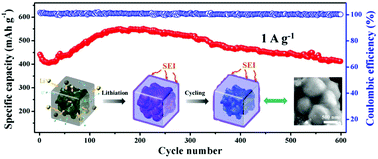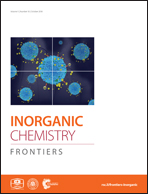Tailoring yolk–shell FeP@carbon nanoboxes with engineered void space for pseudocapacitance-boosted lithium storage†
Abstract
As one kind of promising high-capacity anode material for lithium ion batteries (LIBs), iron phosphide (FeP) has recently attracted much attention owing to its high theoretical capacity. However, the FeP anode materials also suffer from the common problems of intrinsically poor electrical conductivity and drastic volume expansion. Here, we design and construct yolk–shell FeP@carbon (FeP@C) nanobox composites with void space by an efficient synthetic strategy of combining etching-in-boxes with phosphidation-in-boxes approach. Rational void space is engineered between the FeP cores and carbon shells in the yolk–shell structure, which offers a buffer zone for adapting the volume expansion of FeP core particles without breaking the protective carbon shells upon lithiation. Benefiting from their unique structural advantages, the as-built FeP@C nanoboxes manifest a superb rate capability with high specific capacities of 495.9 and 220.8 mA h g−1 at 1.0 and 10.0 A g−1, respectively. Quantitative kinetic analysis identifies that the high-rate performance mainly stems from the pseudocapacitance-boosted lithium storage contribution rendered by the yolk–shell nanobox structure. Moreover, the engineered void space in the FeP@C yolk–shell nanostructure also endows it with an excellent long-term and durable cycling stability (93.7% capacity retention after 600 cycles at 1.0 A g−1). This work sheds light on the rational design of nanostructured metal-phosphide-based anode materials for high performance LIBs.

- This article is part of the themed collection: Inorganic Chemistry Frontiers HOT articles for 2018


 Please wait while we load your content...
Please wait while we load your content...